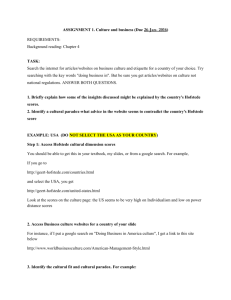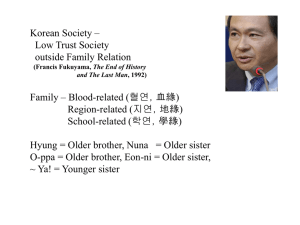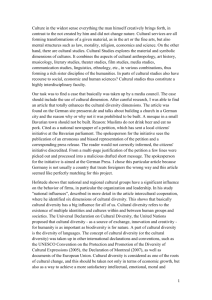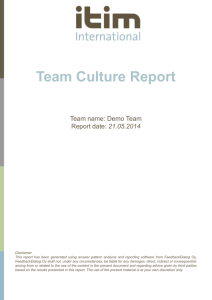Hofstede's six dimensions- Fatima Hamad
advertisement
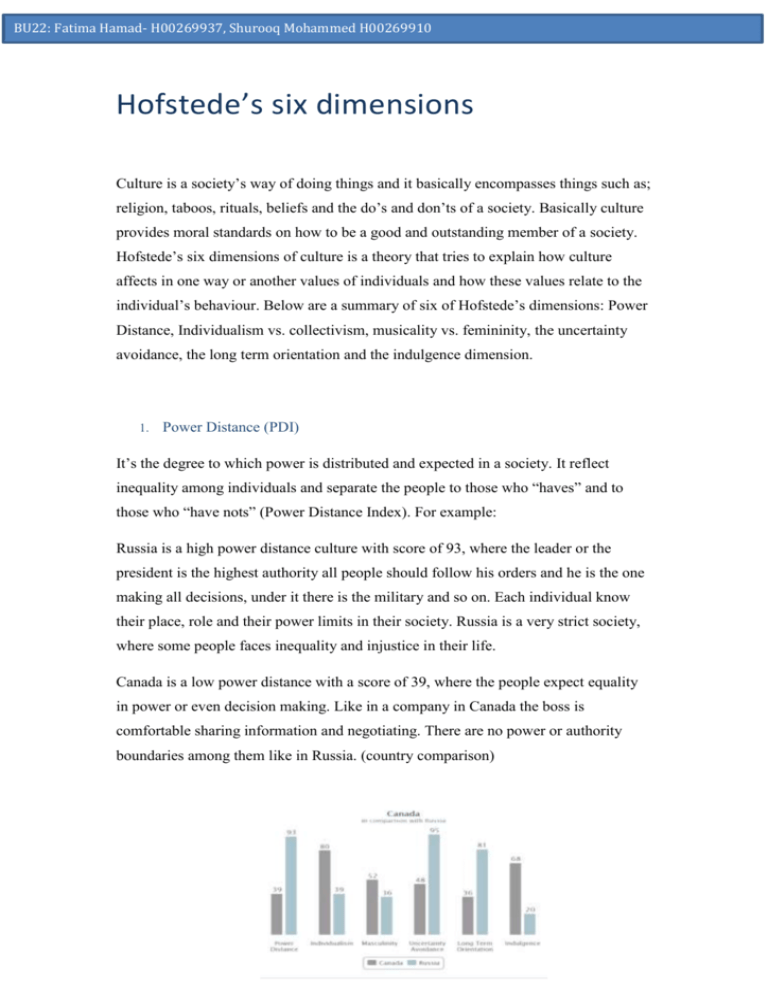
BU22: Fatima Hamad- H00269937, Shurooq Mohammed H00269910 Hofstede’s six dimensions Culture is a society’s way of doing things and it basically encompasses things such as; religion, taboos, rituals, beliefs and the do’s and don’ts of a society. Basically culture provides moral standards on how to be a good and outstanding member of a society. Hofstede’s six dimensions of culture is a theory that tries to explain how culture affects in one way or another values of individuals and how these values relate to the individual’s behaviour. Below are a summary of six of Hofstede’s dimensions: Power Distance, Individualism vs. collectivism, musicality vs. femininity, the uncertainty avoidance, the long term orientation and the indulgence dimension. 1. Power Distance (PDI) It’s the degree to which power is distributed and expected in a society. It reflect inequality among individuals and separate the people to those who “haves” and to those who “have nots” (Power Distance Index). For example: Russia is a high power distance culture with score of 93, where the leader or the president is the highest authority all people should follow his orders and he is the one making all decisions, under it there is the military and so on. Each individual know their place, role and their power limits in their society. Russia is a very strict society, where some people faces inequality and injustice in their life. Canada is a low power distance with a score of 39, where the people expect equality in power or even decision making. Like in a company in Canada the boss is comfortable sharing information and negotiating. There are no power or authority boundaries among them like in Russia. (country comparison) 2. Individualism vs. Collectivism (IDV) Or in other words “I” or “we”. The “I” For independence and self-reliance, from an individual person it is expected to take care of himself, close family or some friends, without having any obligations to a larger community or group. (H.Hofstede, 2005) For example: Canada is a culture like that with a score of 80. They celebrate the accomplishment of an individual rather than a group like doing the “employee of the month”. Employees like that seek for their benefits and interest whether it was in work or anywhere rather than the interest or benefits of an organization or a community. They emphasize the Individuals personal responsibilities and Human rights like in US and UK. Russia is a country where the group is what matter; its score for individualism is 39. The “we” part. Same as in Pakistan and China also. It’s called collectivism. It is expected from the individuals to be loyal and devote their interest on the group. Like to an extended family or to the organization or even the country. They should consider the group best interest. In these cultures it’s consider shameful for a person to think of his own personal benefits. They build strong trustworthy relations. And Russia is good example of collectivism were in every day challenges you should include your group advantage and dedicate them with concern. (country comparison) 3. Masculinity vs. Femininity (MAS) Masculine society, the Goal Orientation societies were winning is important. Communities like that can be classified as the male traits, such as competition, achievement, success, strength, dominance, assertiveness, and egotism. On the other hand, A Feminine society is usually assumed of having conventional traits, such as caring for others and searching for better quality of life is measured as success. A feminine society can be defined by being supportive, caring, and relationship oriented community. (smitt)For example: Canada with a score of 52 in masculinity, they seek for success and winning all the time. Success equals money to them and Canadians always look for high standard of performance, and try to be ahead in the game (competition advantage). They have Admiration for winners and those are successful achiever will gets the credits. The US, UK and Japan are high musicality communities also. Russia with a score of 36, it’s low spuriously. Meaning they search for quality of life to be successful. And a strong dominant behavior might be okay when it comes from a higher authority like a boss, but is not appreciated among individuals. It’s also no accepted to stand out from your community and being better than others will not gain you any privileges. Iceland and Chili are also low masculinity countries. (country comparison) 4. The uncertainty avoidance dimension It’s basically deals with how members of a certain culture feel threatened by unknown situations and the levels of acceptance for uncertainty of members within a society due to the fact that the future can never be known (Hofstede,2005) . This relates to the degree of anxiety that society members feel when in uncertain or unknown situations. For example, a country with very high uncertainty scores will have low tolerance towards uncertain circumstances; such a society tries to minimize the uncertainty levels by having very strict laws and regulations. On the other hand a society that has low uncertainty avoidance is a society that is basically less concerned about ambiguity and is very tolerant of different opinions and the society eventually becomes very adaptive to changes as it is always willing to take on risks (Hofstede, 2005). On the uncertainty avoidance, Canada’s culture is more of uncertainty accepting. This is evidenced by the fact that the Canadian citizens are more adaptive to changes, are very innovative especially in technological advances and are also willing to take in risks and new ideas, hence their culture is very open to changes. The Russian culture tends to be more conservative as the citizens are not aggressive and willing to take on new risks. (country comparison) 5. Long-term orientation It exists when you focus and plan for the future and is characterized by cases of postponing short term success in order to be able to focus and prepare for the long term success, which is basically the future. (Hofstede's Cultural Dimensions ) Hence, long term oriented societies foster towards future rewards such as saving and being adaptive to changes while short term oriented societies tend to only focus on the past and present orientations such as respect for traditions and pride. (Dimensions of national Cultures ) On long-term orientation, Canada tends to be exhibit normative characteristics where the people here have little saving habits, highly focus on achieving results and they have high regard and respect for the tradition. Russia is more pragmatic in nature which basically means they focus less on the past and the present, but are always preparing for the future, they don’t focus more on achieving fast and quick results. (country comparison) 6. Indulgence It basically means a society that highly allows the gratification of its members’ passions and does not restrict nor regulate human passions such as having fun and socialization in the society. On the other hand a society that regulates the needs of their members by for example, having strict social rules is called a restraint society. Hence relatively weak control is known as indulgence while strong control over the passions and drives of the members of the society is known as restraint, hence through this some cultures can be described as highly indulgent while others are highly restraint in nature. (H.Hofstede, 2005) On examples and comparisons of the Canadian and the Russian culture based following can be analysed. One can out rightly say that the Canadian culture is highly indulgent as the Canadian citizens’ exhibit willingness to realize their desires with cases of enjoying life and having lots of fun, hence they can be said to place a higher value on the importance of leisure time. (Hofstede's Cultural Dimensions )On the other hand the Russian culture is very restraint, as the citizens of the country do not place as much importance time to leisure time as compared to the Canadian people. (H.Hofstede, 2005) Bibliography country comparison. (n.d.). Retrieved from the hofstede center: http://geerthofstede.com/canada.html Dimensions of national Cultures . (n.d.). Retrieved from geert hofstede: http://geerthofstede.nl/dimensions-of-national-cultures H.Hofstede, G. (2005). Where cultures meet; a cross-cultural comparison of business meeting styles. london: Sander Schroevers. Hofstede's Cultural Dimensions . (n.d.). Retrieved from mind tools: http://www.mindtools.com/pages/article/newLDR_66.htm Power Distance Index. (n.d.). Retrieved from Investopedia : http://www.investopedia.com/terms/p/power-distance-index-pdi.asp smitt, C. (n.d.). Culutre Matters. Retrieved from Masculinity and Femininity; Culture Matters: http://culturematters.com/masculinity-and-femininity-culturematters/

